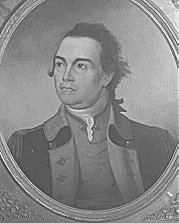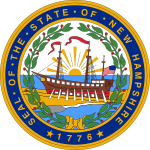
The Twelfth Amendment to the United States Constitution provides the procedure for electing the president and vice president. It replaced the procedure in Article II, Section 1, Clause 3, under which the Electoral College originally functioned. The amendment was proposed by Congress on December 9, 1803, and was ratified by the requisite three-fourths of state legislatures on June 15, 1804. The new rules took effect for the 1804 presidential election and have governed all subsequent presidential elections.

The 1788–89 United States presidential election was the first quadrennial presidential election. It was held from Monday, December 15, 1788, to Wednesday, January 7, 1789, under the new Constitution ratified that same year. George Washington was unanimously elected for the first of his two terms as president and John Adams became the first vice president. This was the only U.S. presidential election that spanned two calendar years without a contingent election and the first national presidential election in American history.

The 1792 United States presidential election was the second quadrennial presidential election. It was held from Friday, November 2, to Wednesday, December 5, 1792. Incumbent President George Washington was elected to a second term by a unanimous vote in the electoral college, while John Adams was re-elected as vice president. Washington was essentially unopposed, but Adams faced a competitive re-election against Governor George Clinton of New York.

Josiah Bartlett was an American Founding Father, physician, statesman, a delegate to the Continental Congress for New Hampshire, and a signatory to the Declaration of Independence and Articles of Confederation. He served as the first governor of New Hampshire and chief justice of the New Hampshire Superior Court of Judicature.

William Eustis was an early American physician, politician, and statesman from Massachusetts. Trained in medicine, he served as a military surgeon during the American Revolutionary War, notably at the Battle of Bunker Hill. He resumed medical practice after the war, but soon entered politics.

The 1788–89 United States House of Representatives elections were the first U.S. House of Representatives elections following the adoption of the Constitution of the United States. Each state set its own date for its congressional elections, ranging from November 24, 1788, to March 5, 1789, before or after the first session of the 1st United States Congress convened on March 4, 1789. They coincided with the election of George Washington as the first president of the United States.

The 1790–91 United States Senate elections were held on various dates in various states. These U.S. Senate elections occurred during the first midterm election cycle, which took place in the middle of President George Washington's first term. As these elections were prior to the ratification of the Seventeenth Amendment in 1913, senators were chosen by state legislatures. Senators were elected over a wide range of time throughout 1790 and 1791, and a seat may have been filled months late or remained vacant due to legislative deadlock. In these elections, terms were up for the nine senators in Class 1.
Massachusetts law required a majority vote, necessitating additional votes if no one won a majority. This was necessary in 4 of the districts.
Elections to the Massachusetts Senate were held during 1788 to elect 40 State Senators. Candidates were elected at the county level, with some counties electing multiple Senators.

The 1833–34 Massachusetts gubernatorial election consisted of a popular election held on November 11, 1833 and a legislative vote held in January 1834. The task of electing the governor fell to the Massachusetts General Court because no candidate received the constitutionally required majority of the popular vote.

The 1812 New Hampshire gubernatorial election was held on March 10, 1812.

The 1817 New Hampshire gubernatorial election was held on March 11, 1817.

The 1785 New Hampshire gubernatorial election was held on 8 March 1785 in order to elect the President of New Hampshire. Candidates consisted of John Langdon, George Atkinson, John Sullivan and Josiah Bartlett. Since no candidate received a majority in the popular vote, Langdon was elected by the New Hampshire General Court per the state constitution, despite having come in second in the popular vote.

The 1787 New Hampshire gubernatorial election was held on 13 March 1787 in order to elect the President of New Hampshire. Incumbent Federalist President John Sullivan defeated Anti-Federalist candidate and former President John Langdon, 1785 President Anti-Federalist candidate Josiah Bartlett and Federalist judge Samuel Livermore. Since no candidate received a majority in the popular vote, Sullivan was elected by the New Hampshire General Court per the state constitution, despite having come in second in the popular vote.

The 1788 New Hampshire gubernatorial election was held on 11 March 1788 in order to elect the President of New Hampshire. Incumbent Federalist President John Sullivan was defeated in his re-election bid by Anti-Federalist candidate and former President John Langdon, who had initially finished first in the popular vote during the previous President election.

The 1789 New Hampshire gubernatorial election was held on 10 March 1789 in order to elect the President of New Hampshire. Federalist candidate and former President John Sullivan defeated incumbent Acting President John Pickering and 1785 & 1787 President Anti-Federalist candidate Josiah Bartlett. Since no candidate received a majority in the popular vote, Sullivan was elected by the New Hampshire General Court per the state constitution.

The 1791 New Hampshire gubernatorial election was held on 8 March 1791 in order to elect the President of New Hampshire. Incumbent Anti-Federalist President Josiah Bartlett was re-elected unopposed.

The 1792 New Hampshire gubernatorial election was held on 13 March 1792 in order to elect the Governor of New Hampshire. Incumbent Anti-Federalist President/Governor Josiah Bartlett was re-elected unopposed.

The 1793 New Hampshire gubernatorial election was held on 12 March 1793 in order to elect the Governor of New Hampshire. Incumbent Anti-Federalist Governor Josiah Bartlett defeated former Anti-Federalist Governor John Langdon, Federalist candidate John Taylor Gilman and Anti-Federalist candidate Timothy Walker.

The 1824 New Hampshire gubernatorial election was held on 9 March 1824 in order to elect the Governor of New Hampshire. Former Democratic-Republican United States Senator from New Hampshire David L. Morril defeated incumbent Democratic-Republican Governor Levi Woodbury and former Federalist Governor Jeremiah Smith. Since no candidate received a majority in the popular vote, Morril was elected by the New Hampshire General Court per the state constitution.
















